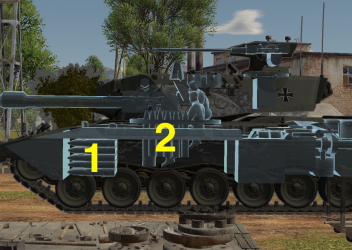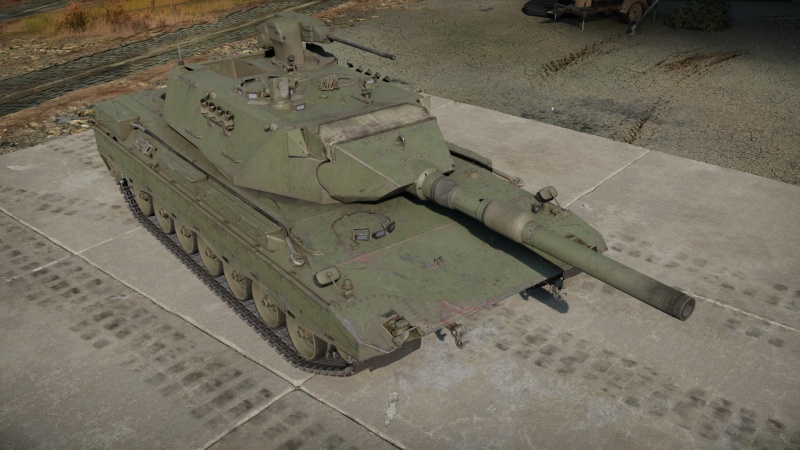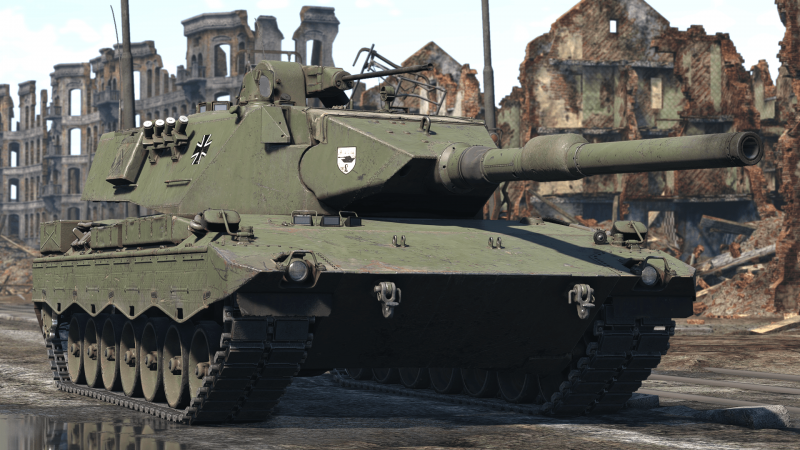Difference between revisions of "Leopard 2K"
m (→Pros and cons) (Tag: Visual edit) |
m (→Pros and cons) (Tag: Visual edit) |
||
| Line 152: | Line 152: | ||
* Reload is slower than other Leopard 2 models | * Reload is slower than other Leopard 2 models | ||
* Very high profile, the 20 mm gun always sticks out behind cover | * Very high profile, the 20 mm gun always sticks out behind cover | ||
| − | * Stock HEATFS round struggles against some enemy vehicles' | + | * Stock HEATFS round struggles against some enemy vehicles' armor, especially those with ERA or composite armour |
* Doesn't have access to thermal imaging system | * Doesn't have access to thermal imaging system | ||
* Limited ammo selection | * Limited ammo selection | ||
* Requires skill to fully utilize its potential | * Requires skill to fully utilize its potential | ||
* You need to invest some skill points on the driver to actually benefit from its mobility | * You need to invest some skill points on the driver to actually benefit from its mobility | ||
| − | * The 20mm | + | * The 20mm often fails to penetrate light tanks but thats rare |
* The 20 mm has HVAP-T(APCR) as ammo, thus it has very poor post-penetration damage | * The 20 mm has HVAP-T(APCR) as ammo, thus it has very poor post-penetration damage | ||
* Other contemporary MBTs can be faster or almost as fast as the Leopard 2k | * Other contemporary MBTs can be faster or almost as fast as the Leopard 2k | ||
Revision as of 02:34, 20 September 2023
| This page is about the German medium tank Leopard 2K. For other versions, see Leopard 2 (Family). |
Contents
Description
The Leopard 2K is a rank VII German medium tank with a battle rating of 9.7 (AB/RB/SB). It was introduced in Update 1.77 "Advancing Storm".
General info
Survivability and armour
| Armour | Front (Slope angle) | Sides | Rear | Roof |
|---|---|---|---|---|
| Hull | 160 mm Upper 120 mm Lower |
65 / 95 mm* Top 35 / 110 mm* Bottom |
38 / 48 mm* | 20 mm |
| Turret | 160-350 / 220-500 mm* Turret front | 60 / 90 mm* | 46 / 96 mm* | 20 mm |
* Kinetic / Chemical
Notes:
- Suspension wheels are 15 mm thick, tracks are 20 mm thick, and torsion bars are 10 mm thick.
Mobility
| Game Mode | Max Speed (km/h) | Weight (tons) | Engine power (horsepower) | Power-to-weight ratio (hp/ton) | |||
|---|---|---|---|---|---|---|---|
| Forward | Reverse | Stock | Upgraded | Stock | Upgraded | ||
| Arcade | 81 | 81 | 50 | 2,032 | 2,862 | 40.64 | 57.24 |
| Realistic | 73 | 73 | 1,327 | 1,500 | 26.54 | 30 | |
The mobility of the Leopard 2K is astonishing, making it one of the most agile MBTs at its BR, able to reach a speed of 70 km/h (RB) on road.
Modifications and economy
Armaments
Main armament
The Leopard 2K's gun is a 120 mm Rheinmetall L44. It can be found on the later models of the tank, such as the Leopard 2A4 and Leopard 2A5. The rounds that the Leopard 2K gets are DM12 HEATFS, DM13 APFSDS, and DM23 APFSDS just like the Leopard 2A4. Being fitted with a 120 mm Rheinmetall gun it is effective at all ranges, capable of penetrating tanks even 1,000 m away
| 120 mm Rh120 L/44 | Turret rotation speed (°/s) | Reloading rate (seconds) | |||||||||||
|---|---|---|---|---|---|---|---|---|---|---|---|---|---|
| Mode | Capacity | Vertical | Horizontal | Stabilizer | Stock | Upgraded | Full | Expert | Aced | Stock | Full | Expert | Aced |
| Arcade | 41 | -9°/+20° | ±180° | Two-plane | 38.1 | 52.7 | 64.0 | 70.8 | 75.3 | 8.71 | 7.71 | 7.10 | 6.70 |
| Realistic | 23.8 | 28.0 | 34.0 | 37.6 | 40.0 | ||||||||
Ammunition
| Penetration statistics | |||||||
|---|---|---|---|---|---|---|---|
| Ammunition | Type of warhead |
Penetration @ 0° Angle of Attack (mm) | |||||
| 10 m | 100 m | 500 m | 1,000 m | 1,500 m | 2,000 m | ||
| DM12 | HEATFS | 480 | 480 | 480 | 480 | 480 | 480 |
| DM13 | APFSDS | 393 | 390 | 384 | 376 | 367 | 359 |
| DM23 | APFSDS | 410 | 408 | 401 | 393 | 384 | 376 |
| Shell details | ||||||||||||
|---|---|---|---|---|---|---|---|---|---|---|---|---|
| Ammunition | Type of warhead |
Velocity (m/s) |
Projectile mass (kg) |
Fuse delay (m) |
Fuse sensitivity (mm) |
Explosive mass (TNT equivalent) (kg) |
Ricochet | |||||
| 0% | 50% | 100% | ||||||||||
| DM12 | HEATFS | 1,140 | 13.5 | 0.05 | 0.1 | 2.15 | 65° | 72° | 77° | |||
| DM13 | APFSDS | 1,650 | 4.44 | - | - | - | 78° | 80° | 81° | |||
| DM23 | APFSDS | 1,640 | 4.3 | - | - | - | 78° | 80° | 81° | |||
Ammo racks

| Full ammo |
1st rack empty |
2nd rack empty |
Visual discrepancy |
|---|---|---|---|
| 41 | 11 (+30) | 1 (+40) | No |
Note:
- The 2nd ammo rack is a first-stage ammo stowage and will refill from the 1st rack.
Machine guns
The tank has a 20 mm anti-aircraft gun situated on top of the turret which can fire over cover and be used to knock out gun barrels and tracks, light tanks, helicopters and planes. The belts are alternating HEFI-T/HVAP-T, with 57 mm of penetration at 0 degrees at 10 m. The 20 mm has quite good elevation, and rotates independently from the turret, able to surprise light tanks attempting to flank following turret ring immobilization.
| 20 mm Rh202 | ||||
|---|---|---|---|---|
| Mount | Capacity (Belt) | Fire rate | Vertical | Horizontal |
| Pintle | 750 (750) | 900 | -9°/+45° | ±180° |
| 7.62 mm MG3A1 | ||||
|---|---|---|---|---|
| Mount | Capacity (Belt) | Fire rate | Vertical | Horizontal |
| Coaxial | 4,000 (1,000) | 1,200 | N/A | N/A |
Usage in battles
Stock gameplay:
As with any vehicle, the Leopard 2K finds itself at a serious disadvantage while stock. Without access to the APFSDS rounds, users will need to play more carefully. While the DM12 HEATFS round is powerful, it struggles against composite armour and ERA, as well as having lacklustre post-penetration effects. Players will have to aim more carefully to deal effective damage with the DM12 HEAT round.
Spaded gameplay:
The Leopard 2K is a powerful tank. The DM23 APFSDS round has adequate penetration, and it should be easy to destroy most enemy vehicles. The gun, ammo, and reload rate are comparable to other main battle tanks of the battle rating. The Leopard 2K does however struggle in some regards against top of the line tanks such as the Leopard 2A5 and M1A2 Abrams. The armour on the Leopard 2K is rather limited, only effective against autocannon fire. Additionally, the lack of thermals means that it will be difficult for Leopard 2K players to spot enemy tanks before they are spotted. The biggest advantage is the speed of the 2K.
Long range engagements:
The Leopard 2K is capable at long range, but is outclassed by many other vehicles. The cannon is powerful, but not especially so compared to its adversaries. The biggest issues the Leopard 2K will face in regards to long range engagements are the thin turret armour and lack of thermals. While the DM13 APFSDS round will fail to penetrate the turret cheeks of vehicles like the Challenger Mk.2 and T-64B, their rounds will have no such trouble with the Leopard 2K. The lack of thermals makes it difficult to scout for enemies through foliage, meaning trying to snipe is not an effective strategy against any enemies equipped with thermals, as they will almost certainly spot you first.
Gameplay summary:
Although the Leopard 2K is somewhat weak when stock, it is an adequate frontline tank while spaded. The good APFSDS round and 20 mm give it a strong position in the German high tier lineup. However, Leopard 2K tank commanders should play to mitigate their disadvantages in thin armour and lack of thermals. The Leopard 2K does best in close to medium range fights.
Pros and cons
Pros:
- 120 mm gun with effective rounds
- Most maneuverable Leopard model
- Very high torque
- Very fast even cross country, even faster on roads.
- Can actually reach top speed on flat grounds
- Can move in reverse as fast as it can move forward
- Has the best optics of all tanks in game with 8x-16x zoom level
Cons:
- Thin armor overall
- Reload is slower than other Leopard 2 models
- Very high profile, the 20 mm gun always sticks out behind cover
- Stock HEATFS round struggles against some enemy vehicles' armor, especially those with ERA or composite armour
- Doesn't have access to thermal imaging system
- Limited ammo selection
- Requires skill to fully utilize its potential
- You need to invest some skill points on the driver to actually benefit from its mobility
- The 20mm often fails to penetrate light tanks but thats rare
- The 20 mm has HVAP-T(APCR) as ammo, thus it has very poor post-penetration damage
- Other contemporary MBTs can be faster or almost as fast as the Leopard 2k
- Lack of thermal sights limits the sniping capability of the tank
History
In the 1960s, Germany and the United States were jointly-developing the MBT-70, and Germany was contractually prevented from developing any new MBTs independently until the joint project with the US was completed.
But development problems plagued the MBT-70 project, and it appeared that the vehicle would not be finished within an acceptable time frame—so Germany found a way to bypass contractual limitations for the MBT-70 development.
Instead of ordering the development of a new tank, the German government issued an order to the Porsche company to research ways to improve the Leopard I tank already in service with the German army. This enabled Germany to research a more advanced fighting vehicle without breaching the contract signed with the US.
Porsche's first study of the Leopard I revealed a lot of room for improvement, and second study focusing on upgrading the Leopard I to match the MBT-70's firepower was launched almost immediately. This eventually resulted in the construction of two prototype vehicles: one in 1969, and one in 1970 nicknamed Keiler (tusker).
In the early 1970s, Germany was able to back out of the MBT-70 project due to spiraling development costs. Instead, they continued work on the development of the Keiler, which was renamed to Leopard 2.
The Leopard 2 project was expected to yield two versions: the Leopard 2K armed with a cannon, and the Leopard 2FK armed with a gun/launcher similar to the MBT-70. In 1971, ten prototypes were ordered, and seven more orders followed shortly thereafter.
To get the most out of their prototypes, German engineers equipped each one with different components to determine what worked best. Some Leopard 2 versions were equipped with a 105 mm smoothbore cannon, whereas others were fitted with 120 mm smoothbore cannons. Some prototypes received a hydraulic suspension while others didn't, and there was even a version equipped with the 20 mm anti-air mount on the turret (similar to the one found on the Kpz-70).
Sixteen out of seventeen Leopard 2 prototypes were built and tested, yielding many refinements to the Leopard 2 design. Subsequent models further increased the Leopard 2's capabilities, with each variant making it more powerful—and ultimately into the Leopard 2 known today.
- From Devblog
Media
- Skins
- Videos
See also
Links to the articles on the War Thunder Wiki that you think will be useful for the reader, for example:
- reference to the series of the vehicles;
- links to approximate analogues of other nations and research trees.
External links
| Germany medium tanks | |
|---|---|
| Pz.III | Pz.III B · Pz.III E · Pz.III F · Pz.III J · Pz.III J1 · Pz.III J1 TD · Pz.III L · Pz.III M · Pz.III N |
| Pz.IV | Pz.IV C · Pz.IV E · Pz.IV F1 · Pz.IV F2 · Pz.IV G · Pz.IV H · Pz.IV J · Pz.Bef.Wg.IV J |
| Pz.V | VK 3002 (M) · Panther A · Panther D · Panther F · Panther G · Ersatz M10 · Panther II |
| M48 upgrades | M48A2 G A2 · M48 Super |
| Leopard 1 | Leopard I · Leopard A1A1 · Leopard A1A1 (L/44) · Leopard 1A5 · C2A1 · Turm III |
| Leopard 2 | PT-16/T14 mod. · Leopard 2K · Leopard 2AV |
| Leopard 2A4 · Leopard 2 (PzBtl 123) · Leopard 2A4M · Leopard 2 PL · Leopard 2A5 · Leopard 2 PSO · Leopard 2A6 · Leopard 2A7V | |
| Trophies | ▀M4 748 (a) · ▀T 34 747 (r) |
| Other | Nb.Fz. · KPz-70 |
| USA | mKPz M47 G · M48A2 C |
| USSR | ◊T-72M1 |






